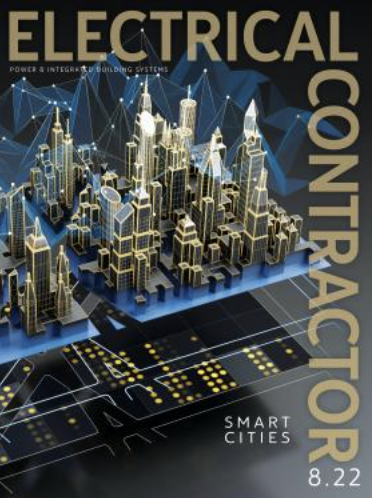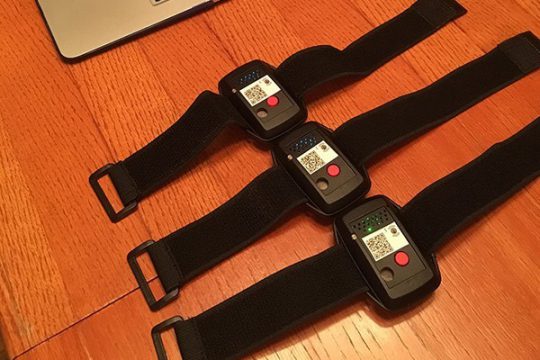Electrical Contractor Magazine Discusses MākuSafe as Wearable PPE
August 22, 2022
MākuSafe’s wearable technology was recently explored in an article in Electrical Contractor Magazine as part of wearable smart technology in PPE.

Adding Intelligence to PPE: Protective gear gets an upgrade with wearable smart technology
As workplace hazards have evolved, personal protective equipment has had to adapt. A variety of high- and low-cost solutions offer many benefits, and contractors have a growing selection of choices to make regarding how they keep their workers safe.
At the heart of work site safety, PPE centers around protective clothing needed to prevent injury, such as gloves, hard hats and safety glasses. Proper training and on-site safety meetings are irreplaceable.
With wearable technology, the definition of PPE has expanded to include tools that connect workers with project managers, provide contextual data to those in the field or even sense conditions, anticipate risks and transmit alerts wirelessly. Some of these systems are already used in sites around the United States, while others are still in the earlier development stages.
This is one of many trends accelerated by the COVID-19 pandemic. Workers in the field have been wearing masks and focusing on distancing, and contractors are increasingly contending with pandemic-related worker shortages and new, less-experienced recruits. More than ever, workers are coming into jobs with expectations about safety.
“I think one of the positive outcomes of COVID is that it has placed a major emphasis on safety with integrating PPE,” said Alexander Dougherty, Eastern Kentucky University assistant professor within the School of Safety, Security and Emergency Management.
When it comes to recruitment and retention, contractors are making themselves more competitive for the latest, more safety-minded members of the workforce, Dougherty noted, and in part that means offering technology with safety benefits.
“I think we all take inherent risks, but if you have a company that has an unfortunately high injury rate—or even a fatality—that resonates and leads a company to focus on taking a step back to look at their safety culture,” he said.
Safety-based expectations are changing across the generations. While baby boomers and Generation X members may still focus solely on training and proper safety procedures, younger generations have more technology-based expectations and a lower tolerance for risk.
“We’re seeing that safety concerns are more prevalent [with the younger workers],” Dougherty said.
Many people are already using wearable technology, with electricians bringing smartwatches and smartphones to work that track details such as location and relevant weather conditions.
Many industries are taking part in the technology transition. The National Football League uses sensors in players’ helmets and shoulder pads to track contact and impact data. Military agencies provide wearable technology as part of some combat training and support. NASA astronauts are equipped with biometric sensors built into wearable health technology. Even some firefighters are wearing condition-monitoring systems, Dougherty said.
Enhancing workplace communication
The construction industry is sure to follow. Falls are among the highest safety risks for electricians, along with ergonomics-based injuries, flash burns and electric shock/electrocution. Some solutions address fall detection and lone worker alerts, while others center around features such as lockout/tagout verification. For every piece of mechanical or electric industrial equipment, there’s a procedure to confirm all energy sources are de-energized or controlled, but there are still potentials for miscommunication.
“You have to effectively communicate, not only to your front-line supervisors, but [to those] throughout the entire facility or to whoever is around,” Dougherty said. “I think the goal of anything with hazard mitigation is to effectively communicate it.”
Some equipment already requires a bar code scan to ensure it can be safely used. Other technology in the research phase uses near-field communication or a radio frequency identification chip worn by a frontline worker. Other systems use Bluetooth to interface with a piece of equipment. These devices can transmit data to help identify where that individual is and whether they are within range of a specific piece of equipment; potentially alerting an electrician when they are within range of a live current. The data can also be viewed by supervisors using a work site’s Wi-Fi network.
Other PPE is being developed simply to resolve new or unexpected safety risks, such as safety glasses fogging when electricians wear masks. Some companies are working on solutions, from antifog agents to reinventing a half- or full-face respirator to protect a worker’s visibility on the job site.
“The good thing about the PPE suppliers around the nation is that when a major issue such as this is brought to the forefront, they run to R&D to come up with a workable solution,” said Wesley Wheeler, NECA’s executive director of safety.
Masks that divert the exhaled air away from the glasses and lenses that have new and improved antifog coatings are just two of the improvements that have been coming out of the pandemic, he said.
Choosing the right technology
When it comes to fall protection, numerous companies offer proximity systems that alert a worker when they are in close proximity to an edge, and that can be beneficial, Wheeler said. Other sensors provide detection, rather than helping prevent falls. For instance, some systems can sound alerts after a fall and help supervisors locate that individual. However, privacy concerns need to be addressed upfront.
“The drawback of any individual worker proximity sensor is the anxiety of the worker who believes he is being monitored for other reasons,” he said, so managers need to clearly educate workers about the purpose before implementing a proximity system.
Another safety risk contractors face is ergonomic. Most of the solutions under discussion now are related to exoskeletons and how these wearables can protect the worker from musculoskeletal disorders and injuries. While they may be effective, they are still not gaining favor in the construction industry, Wheeler noted. Cost may be one obstacle, and many of these systems are not yet widely available.
“While still in its infancy, as the cost of incorporating this technology starts to come down, you should see more of these devices in the field,” he said.
Other PPE technology includes engineering garments that are breathable, wickable and lighter—while still being arc-rated for electrical workers.
Companies are also developing and manufacturing new hard hat designs that are more comfortable to wear, protective and lighter to address fatigue and visibility. While these new hard hats are not required by the Occupational Safety and Health Administration, many companies and utilities are shifting to these designs anyway, Wheeler said, as long as they can get the proper electrical rating to protect exposed workers.
Established companies—such as 3M, Draeger and Honeywell—are working on additional PPE offerings, while technology startups like Corvex Connected Worker, Eleksen, Kenzen, Bodytrak and Seebo are all offering some form of commercially available technology.
………..Read the full article here.
Read specific information related to MākuSafe below:
Data tracking and collection
Another smart PPE alternative is a system focused on specific common conditions that affect worker health and productivity. MakuSafe, Des Moines, Iowa, offers a wearable solution that tracks ambient temperature, sound levels, falls, air quality and light level, said Tom West, the company’s vice president of marketing.
“We’ve got thousands of users on our platform actively wearing MakuSafe every day,” in manufacturing, logistics and warehousing, among other sectors. The technology is another tool for workers facing a variety of potential hazards, he said.
The company’s armband sensors can tether to a smartphone through Bluetooth or transmit real-time data over Wi-Fi, while a third option is to upload data at the end of the shift as the device is returned to a base station.
The data collected could help project managers understand conditions over time and adjust accordingly. The technology also can identify trends (e.g., continuous slips at a loading dock) using sensor and GPS data, and artificial intelligence to make sense of those trends. Additionally, repetitive movement, improper lifting and tool adjustments can be identified to fit a worker’s physical needs. The technology has detected risks on construction sites that ultimately may have prevented an injury, West said.
OSHA does not yet endorse these technological safety solutions, but that could change. West takes part in efforts with members of OSHA and the Department of Labor to discover tools that help prevent risks, and the company has found that workers’ compensation insurance reports indicated a 50% reduction in claims frequency and up to a 90% reduction in the severity of the claims they received.
“Wearables are the future of PPE. They’re very accessible and economical now—about the same cost as a good pair of gloves—and useful in preventing incidents in many environments, including construction,” West said.





